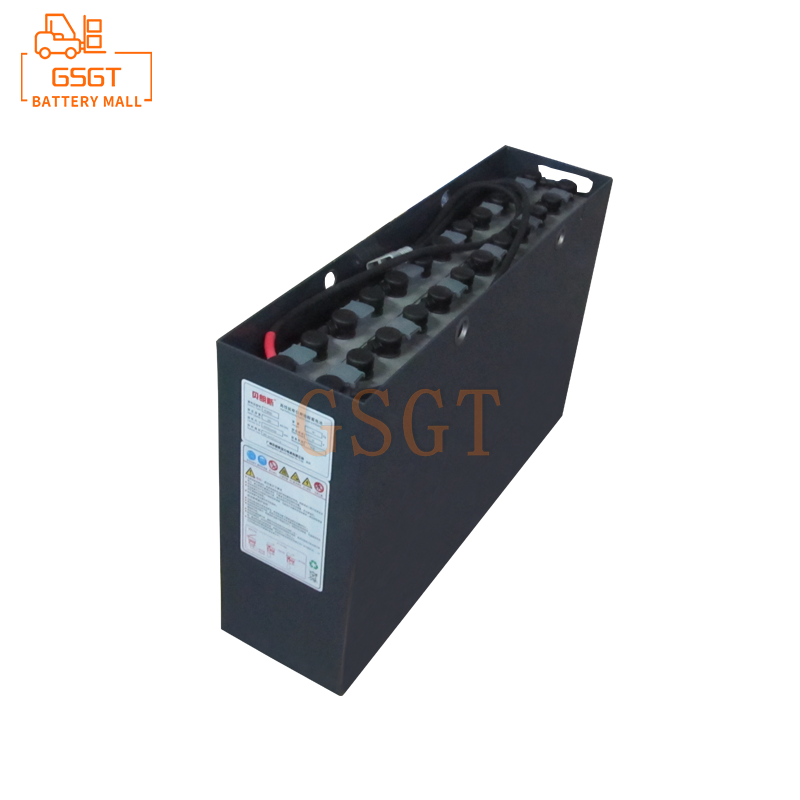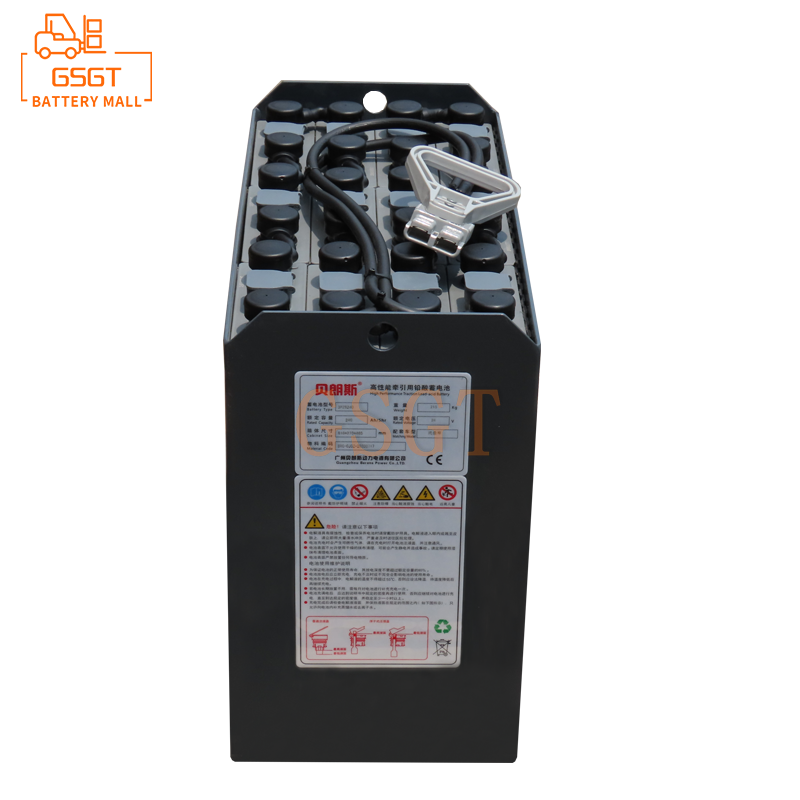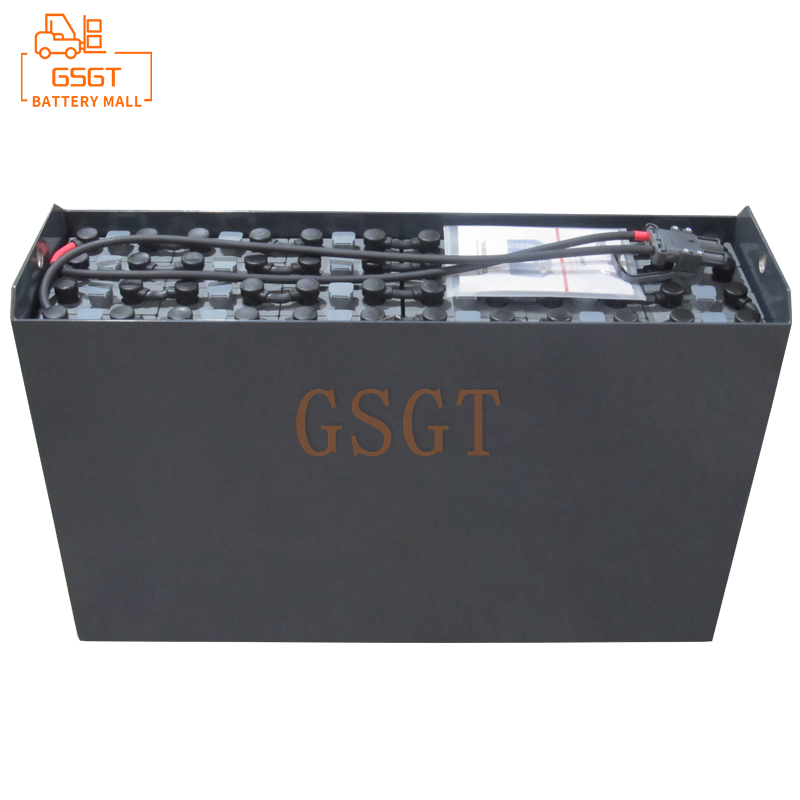Time:2025-05-27 10:42:51
Browse:604
In the modern logistics and warehousing industry, forklifts, as indispensable handling equipment, the performance and lifespan of their power source - lead-acid batteries - directly affect the operational efficiency and cost control of enterprises. Forklift lead-acid batteries have become the preferred power source for many enterprises due to their advantages such as mature technology, low cost and good high-current discharge performance. However, if there is a lack of scientific and reasonable maintenance and care, the performance of lead-acid batteries will decline rapidly, their service life will be significantly shortened, and even potential safety hazards may arise. Therefore, it is of vital importance to master the maintenance and care skills of lead-acid batteries in forklifts.
1. Use lead-acid batteries correctly
(1) Avoid excessive discharge
Excessive discharge of lead-acid batteries is one of the important reasons for the decline in their performance. When a battery discharges to a certain extent, the active substances on the plates will undergo irreversible changes, resulting in a decrease in battery capacity. Generally speaking, the discharge depth of lead-acid batteries in forklifts should be controlled within 80%. To accurately monitor the battery's discharge status, forklifts are usually equipped with a battery level display device. Operators should closely monitor the battery level. When the battery level drops to around 20%, they should promptly stop using the forklift and charge the battery. In addition, the degree of battery discharge can also be determined by measuring the terminal voltage of the battery. Different specifications and models of batteries have different discharge termination voltages. In actual use, operations should be carried out in accordance with the battery manual.
(2) Reasonably control the operating temperature
The performance of lead-acid batteries is greatly affected by temperature. In low-temperature environments, the viscosity of the electrolyte in batteries increases, and the diffusion rate of ions slows down, resulting in an increase in the internal resistance of the battery, a decrease in charging and discharging efficiency, and a significant decline in capacity. In a high-temperature environment, the chemical reaction rate of the battery increases, which will accelerate the aging of the plates and the evaporation of the electrolyte, shortening the service life of the battery. Therefore, when using forklift lead-acid batteries, the working environment temperature should be controlled at around 25℃ as much as possible. In the cold winter, measures can be taken to keep the battery warm, such as wrapping the battery with an insulating cover or parking the forklift in a warm indoor area. In the hot summer, it is necessary to pay attention to cooling the battery, avoid direct sunlight and maintain good ventilation and heat dissipation conditions.
(3) Standardize the operation procedures
The standardized operation of the operators is of vital importance for the maintenance and care of lead-acid batteries. When starting a forklift, it is necessary to avoid sudden large current discharge. The correct approach is to first turn the key switch to the "ON" position, wait for a few seconds to allow the vehicle's electronic system to self-check and initialize, and then slowly press the accelerator pedal to start the vehicle. During driving, it is necessary to avoid frequent sudden acceleration, sudden braking and long-term high-speed driving. These operations will increase the discharge current of the battery and accelerate its wear and tear. In addition, when loading and unloading goods with a forklift, it is necessary to keep the goods as stable as possible to avoid unstable load on the forklift motor due to the shaking of the goods, which may affect the performance of the battery.
2. Scientific Charging Management
(1) Choose the appropriate charger
The charging requirements for lead-acid batteries of different specifications and models of forklifts also vary. Therefore, when choosing a charger, it is essential to ensure that the parameters of the charger match those of the battery. The voltage and current output of the charger should meet the rated charging voltage and current requirements of the battery; otherwise, it may lead to undercharging or overcharging of the battery, affecting its performance and lifespan. At the same time, it is recommended to choose a reliable charger with intelligent charging functions. Such chargers can automatically adjust the charging current and voltage according to the battery's charging status, achieving multiple charging modes such as constant current, constant voltage, and float charging, effectively improving charging efficiency and the battery's service life.
(2) Master the correct charging method
Initial charging: Newly purchased lead-acid batteries need to be initially charged before use. The purpose of the initial charging is to fully reduce the active substances on the plates, thereby enhancing the battery's capacity and performance. The initial charging time is generally long, usually requiring 20 to 30 hours. The specific time should be operated in accordance with the battery manual. During the initial charging process, closely monitor the temperature and voltage changes of the battery. When the battery temperature exceeds 45℃, charging should be suspended and resumed only after the temperature drops.
Daily charging: Daily charging should follow the principle of "shallow charging and shallow discharging", that is, do not wait until the battery is completely drained before charging, nor overcharge. During the charging process, when the battery voltage reaches the set charging termination voltage, the charger should automatically switch to float charging state to replenish the self-discharge loss of the battery. The float charging time should not be too long, generally controlled at about 2 to 3 hours. In addition, to extend the battery's service life, it is recommended to perform a full charge and full discharge once a week, that is, to discharge the battery to the terminal voltage and then carry out a complete charging process.
Equalization charging: During the use of lead-acid batteries, the performance of each individual battery will gradually vary, resulting in an unbalanced voltage in the battery pack. To solve this problem, it is necessary to carry out equalization charging regularly. The frequency of equalization charging is generally once every 2 to 3 months. The specific time interval can be adjusted according to the usage of the battery. When performing equalization charging, a dedicated equalization charger should be used to charge each individual battery in the battery pack to the same voltage to ensure consistent performance of the battery pack.
(3) Pay attention to the charging environment
The charging environment has a significant impact on the charging effect and safety of lead-acid batteries. The charging site should be well-ventilated to prevent explosion accidents caused by the accumulation of hydrogen and oxygen produced during the charging process. At the same time, the charging area should be kept away from fire sources, heat sources and flammable and explosive items to ensure charging safety. In addition, the temperature of the charging environment should also be controlled within an appropriate range, generally recommended to be between 5℃ and 35℃. Charging in a low-temperature environment will reduce the battery's charging acceptance capacity and prolong the charging time. Charging in a high-temperature environment will accelerate the aging and damage of the battery.
3. Daily Inspection and Maintenance
(1) Inspection and replenishment of electrolyte
The electrolyte of lead-acid batteries is mainly composed of sulfuric acid and distilled water. Its function is to conduct current and participate in the chemical reactions of the battery. During use, the electrolyte will gradually decrease due to evaporation and chemical reactions. Therefore, it is necessary to regularly check the liquid level and density of the electrolyte. When checking the liquid level, a dedicated liquid level gauge should be used or the liquid level scale line on the battery casing should be observed to make a judgment. When the liquid level is below the minimum scale line, distilled water or special lead-acid battery replenishment fluid should be replenished in time. It is strictly forbidden to use tap water or other impure water, as it may affect the performance of the battery. After replenishing the electrolyte, the battery should be left to stand for a period of time to ensure that the electrolyte is thoroughly and evenly mixed.
When checking the density of the electrolyte, a hydrometer can be used for measurement. The density of the electrolyte is related to the degree of battery discharge and temperature. Generally speaking, at 25℃, the density of the electrolyte in a fully charged battery should be around 1.28g/cm³. If the density of the electrolyte is too low, it indicates that the battery has been over-discharged and should be charged in time. If the density of the electrolyte is too high, it may be due to excessive water evaporation or the addition of inappropriate liquid. Distilled water should be appropriately supplemented for adjustment.
(2) Battery appearance inspection
Regularly inspect the appearance of lead-acid batteries to check if there is any damage, deformation or leakage on the battery casing. If the battery casing is found to be damaged or leaking, the battery should be stopped from use immediately and repaired or replaced. At the same time, it is also necessary to check whether the battery terminals are corroded or loose. Corrosion of the terminal posts will increase the contact resistance of the battery, causing it to heat up during discharge and affecting its performance and lifespan. Loose poles can lead to poor contact and even cause sparking, posing a safety hazard. For slightly corroded terminals, sandpaper or a special cleaner can be used for cleaning, and then a layer of Vaseline or a special battery terminal protector can be applied to prevent further corrosion. For loose terminals, a wrench should be used to tighten the nut to ensure a firm connection.
(3) Inspection of connecting wires
The connection lines of the lead-acid batteries in forklifts are responsible for transmitting the battery's electrical energy to all components of the forklift. The reliability of these connections directly affects the normal operation of the forklift. Therefore, it is necessary to regularly check whether the connecting wires are damaged, aged, loose or not. When inspecting, carefully check whether there are cracks or damages on the outer skin of the connecting wires and whether there are any breaks in the internal wires. If any problem is found with the connecting wires, new ones should be replaced in time. At the same time, it is necessary to check whether the connection lines are firmly connected to the battery terminals and the electrical components of the forklift, and whether the contact is good. For loose connection points, a wrench should be used to tighten the nuts to ensure a tight connection.
(4) Conduct regular performance tests
To keep abreast of the performance status of lead-acid batteries in a timely manner, it is recommended to conduct regular performance tests on the batteries. The main items of performance testing include battery capacity testing, internal resistance testing, charge-discharge curve testing, etc. Through capacity testing, the actual available capacity of the battery can be understood, and it can be determined whether the battery needs maintenance or replacement. Through the internal resistance test, the size of the battery's internal resistance can be evaluated. If the internal resistance is too large, it indicates that the battery's performance has declined and it needs to be repaired or replaced. Through the charge-discharge curve test, the voltage and current changes of the battery during the charging and discharging process can be observed, and the charging and discharging performance of the battery can be analyzed to determine whether it is normal. The frequency of performance testing is generally once every quarter. For batteries with a higher usage frequency or a longer service life, the testing frequency should be appropriately increased.
4. Maintenance of Batteries that Have been Idle for a Long Time
If the lead-acid battery of a forklift needs to be out of service for a long time, appropriate maintenance measures should be taken to prevent the decline and damage of battery performance. First of all, the battery should be fully charged before being out of use. Then, a supplementary charge should be carried out every two weeks to prevent the battery from being discharged due to self-discharge. Secondly, batteries should be stored in a dry, well-ventilated and cool place, avoiding direct sunlight and damp environments. If conditions permit, the battery can be removed from the forklift and stored separately to reduce vibration and shock to the battery. During storage, it is necessary to regularly check the appearance of the battery and the level of the electrolyte. Any problems found should be dealt with promptly. When it is necessary to reuse the battery, a comprehensive inspection and maintenance of the battery should be carried out first to ensure that its performance is normal before putting it back into use.
5. Common Faults and Handling Methods
(1) Battery capacity decline
Battery capacity decline is one of the most common faults of lead-acid batteries. There are many reasons for the decline in battery capacity, such as over-discharge, insufficient charging, abnormal electrolyte density, and sulfation of the plates. The capacity decline caused by excessive discharge and insufficient charging can be addressed by adjusting the usage and charging methods. For abnormal electrolyte density, the electrolyte density should be adjusted according to the actual situation. For plate vulcanization, methods such as pulse repair and chemical repair can be adopted for repair. If the battery capacity drops severely and cannot be restored through repair, a new battery should be replaced in time.
(2) Battery heating
During the charging and discharging process of batteries, a certain amount of heat is generated. However, if the temperature is too high, it is an abnormal situation. The main reasons for battery heating include excessive charging current, insufficient electrolyte, and internal short circuits in the battery. When the battery is found to be overheating, its use or charging should be stopped immediately. Check whether the charging current meets the requirements and whether the electrolyte level is normal. If the charging current is too large, the output current of the charger should be adjusted. If the electrolyte is insufficient, it should be replenished in time. If there is suspicion of an internal short circuit in the battery, it should be sent to a professional maintenance institution for inspection and repair.
(3) Battery leakage
Battery leakage can lead to a reduction in electrolyte, affecting the battery's performance. At the same time, it may also corrode the components of the forklift, posing a safety hazard. The main reasons for battery leakage include damaged battery casing, poor sealing of terminal posts, and blocked exhaust holes, etc. If battery leakage is found, first check whether the battery casing is damaged. If there is any damage, the casing should be replaced in time. Then check whether the terminal post seal is good. For terminal posts with poor sealing, resealing treatment should be carried out. Finally, check if the exhaust hole is blocked. If it is blocked, clean the exhaust hole to ensure smooth exhaust.
In conclusion, the maintenance and care of lead-acid batteries in forklifts is a systematic and meticulous task that requires efforts from multiple aspects such as usage, charging, daily inspection, and long-term maintenance when out of service. Operations must be carried out strictly in accordance with operating procedures and maintenance requirements. Only in this way can the service life of lead-acid batteries be effectively prolonged, the working efficiency of forklifts be improved, the operating costs of enterprises be reduced, and the safe operation of forklifts be ensured at the same time.

$1060

$850

$880

$2530

MESSAGE
Professional And Efficient
Security
Affordable Price
Professional Services